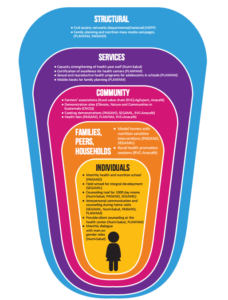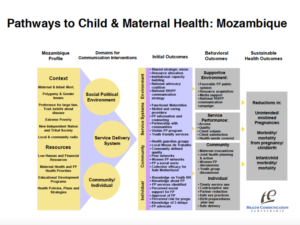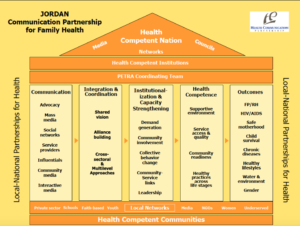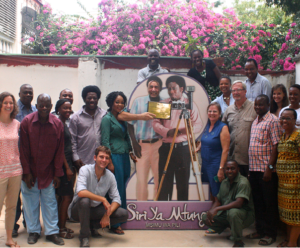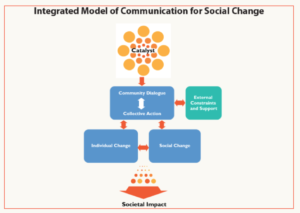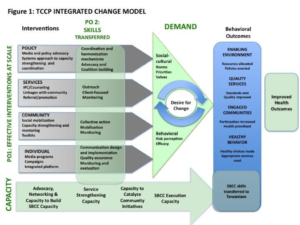Components
Theory and Frameworks
The Importance of Theory
Grounding any SBCC strategy in a theoretical model is important but it can be even more so for an integrated program. A theoretical model lays out a “map” of how and why you expect change to happen. It helps to focus and guide every aspect of the program – from design to implementation and M&E. Given the complexity of an integrated SBCC program, a sound theoretical model can help stakeholders understand the logic behind program decisions and how each partner fits into the overall strategy.
Theory: Socio-Ecological Model
The Socio-Ecological Model is a process which guides communication strategy by accounting for all levels of society that influence individuals. This model moves away from communication as a one-time, one-way "act" towards a view of it as an iterative social process that unfolds over time. For example, each level shown in the model encompasses theories of change for that particular level. In other words, it considers the complex interplay between individual, relationship, community, and societal factors.
Program Experience
(When you see a Program Experience, simply click on the photo to read insights from real integrated SBCC programs.)
Theory: Pathways Model™
The Pathways Model™ recognizes that effective communication is grounded in a particular socio-ecological context, including enabling environments, service delivery systems, communities, husbands and wives, family members and individuals. It helps in identifying and understanding “pathways” to change within these complex systems and developing strategies that address these behavioral pathways, and then creating and mobilizing a comprehensive array of communication approaches to catalyze change. These communication approaches can include digital media, broadcast media, community mobilization, interpersonal communication, advocacy and capacity building to catalyze change.
Program Experience
Theory: Health Competence
Health Competence focuses on the individual’s ability to demand or use health services appropriately or adopt health practices, and can be used across a number of different topics or behaviors. Once health competence is built in one life stage, and an individual achieves specific, visible health results and the resultant improved self-efficacy then carries over to future life stages.
Program Experience
Theory: Bounded Normative Influence
Bounded Normative Influence (BNI) is a group-level theory that explains how a minority can influence the majority. BNI “is the tendency of social norms to influence behavior within relatively bounded, local subgroups of a social system rather than the system as a whole.” A minority position can become the social norm when certain criteria are met – namely, when the minority maintains a majority status within its own, locally bounded portion of the network, allowing it to persist, to recruit adapters in the vicinity and to ultimately establish its behavior or position as the norm for the entire network.
Program Experience
Theory: Social Learning Theory
Social Learning Theory offers a narrative lens and behavioral modeling, which lends itself well to multiple topics. With the premise that people learn through observing the behaviors, attitudes and behavioral outcomes of those that are similar to themselves. The fundamental concepts of social learning theory are modeling, efficacy, and parasocial interaction. Modeling shows someone performing the desired behavior, efficacy describes a feeling of personal empowerment or confidence in one’s ability to perform that behavior, and parasocial interaction takes place when people begin to identify with and think of fictional characters as if they were real people.
Program Experience
Theory: Communication for Social Change
Communication for Social Change (C4SC) is an iterative process where “community dialogue” and “collective action” work together to produce social change in a community to improve the health and welfare of all its members. In other words, this model is a dynamic, iterative process that starts with a “catalyst/stimulus” that can be external or internal to the community. This catalyst leads to dialogue within the community that when effective, leads to collective action and the resolution of a common problem. The model also postulates that every time a community goes through the dialogue and collective-action processes to achieve a set of shared objectives, its potential to cooperate effectively in the future also increases. Likewise, after each problem-solving process is completed, all of the outcomes of social change specified by the CFSC model will be strengthened.
Program Experience
Theory: Theory of Planned Behavior
The Theory of Planned Behavior considers three types of beliefs that tend to guide human behavior:
- Behavioral beliefs, which consider the positive and negative outcomes of the decision
- Normative beliefs, which result in perceived social pressure or subjective norms
- Control beliefs, which help determine self-efficacy, or confidence in one’s ability to perform the behavior
When combined, the three types of beliefs result in the formation of an intention to engage in the behavior (or not). This theory may work well when your goal is to create logical linkages between different topics and behaviors (Source: HC3, 2014).
Theory: Diffusion of Innovations
Diffusion of Innovations (DOI) helps explain and predict factors that influence the adoption of innovations such as products, services or ideas over time. Successful innovations typically spread from a few innovators and early adopters to the rest of the population – early majority, late majority and laggards. Understanding the characteristics of each of these types of adopters can help you apply different strategies to each segment. DOI might be useful for rapid behavior change, especially when used with Social Network Analysis (SNA) or the Positive Deviance Approach (PDA). SNA provides a visual and mathematical analysis of human relationships, showing where there are clusters or groupings in a network, who is in the core of the network, who is on the periphery and who takes on various roles (e.g., connectors, mavens, leaders, bridges and isolates). PDA, on the other hand, identifies people or groups whose “special or uncommon behaviors or strategies enable him/her/them to overcome a problem without special resources and facing similar barriers and challenges as their peers.”
Program Experience
Theory: Customized
Other programs have combined theories or developed their own, based, for example, on how bringing the different topics/behaviors together should lead to greater overall change.


